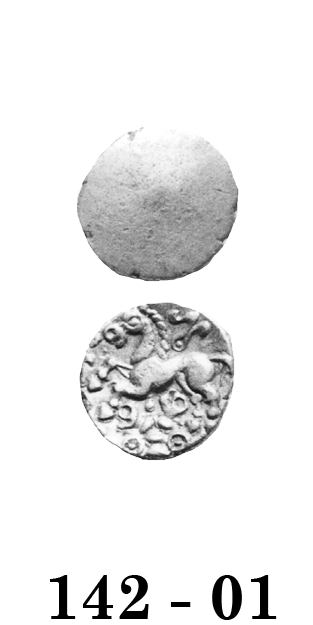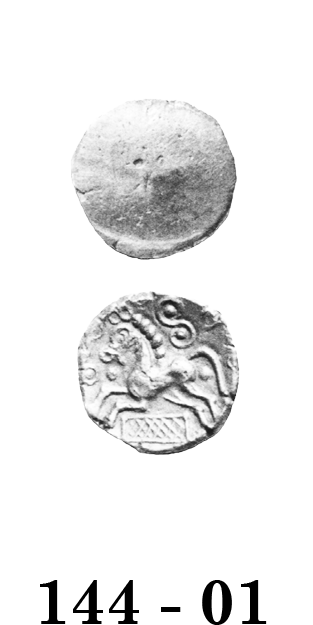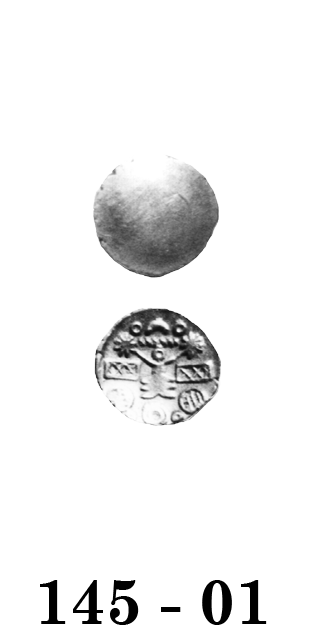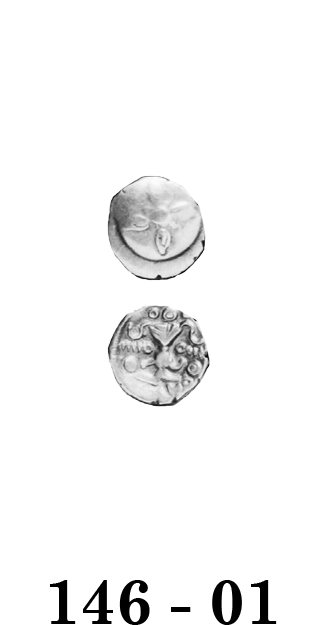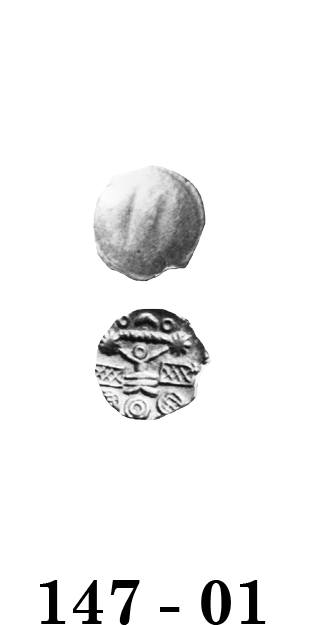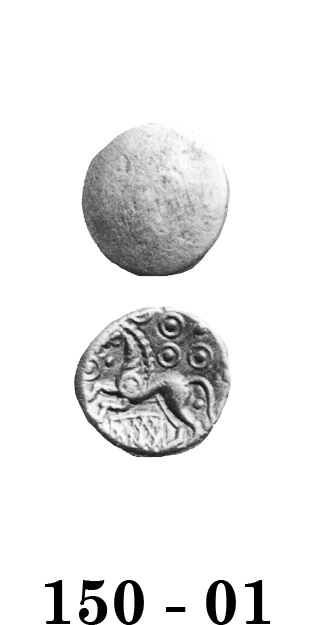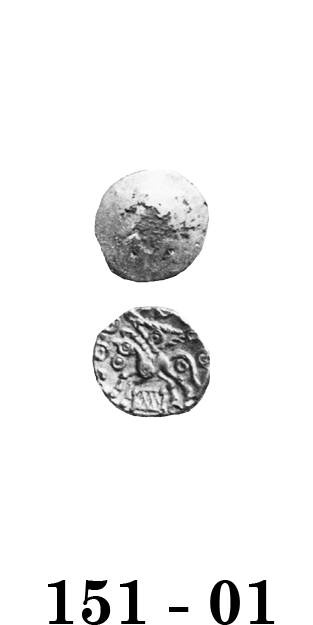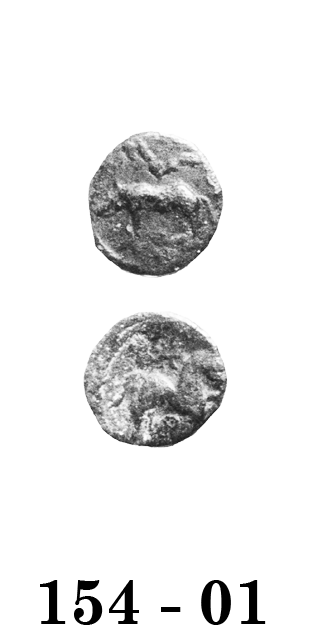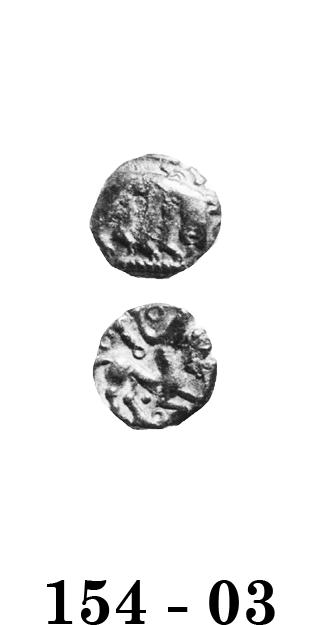
Celtic Coinage of Britain
third edition
Click on coin to see hidden information
Arbitrarily Assigned Coins
The following types, for the most part known from only a handful of examples, are traditionally assigned to the Cantii. There is little reason for doing so, other than they have been found in Kent. The types are of unknown date and may be earlier imports from Gaul.
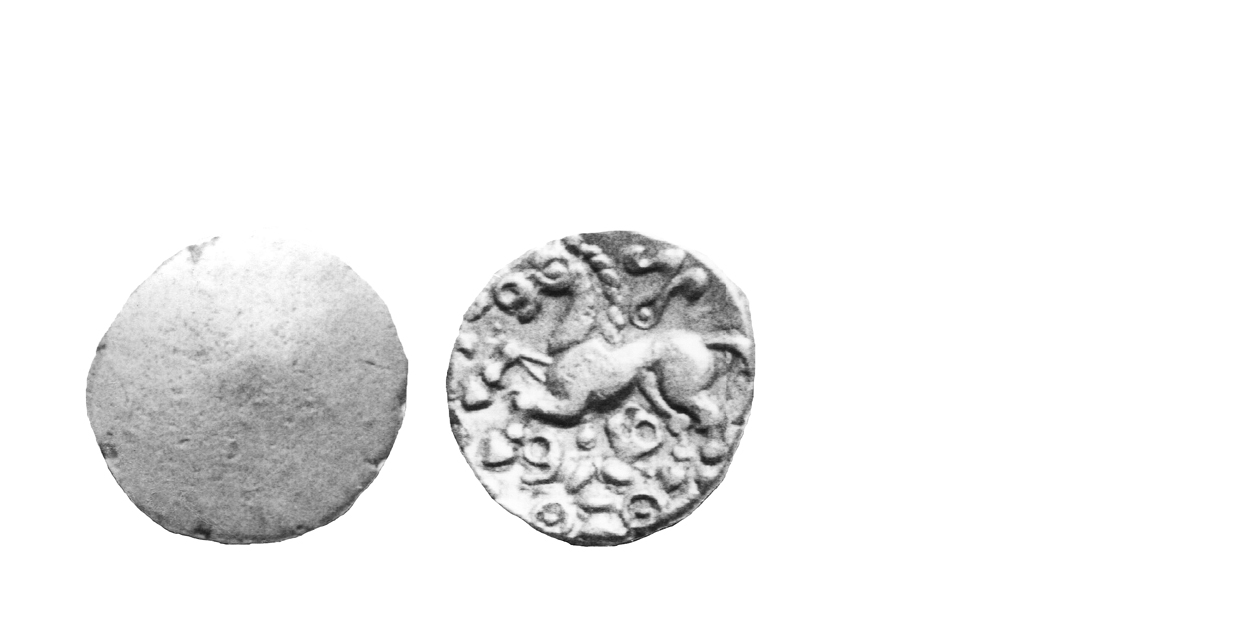
142 - 01 Ornamented Type
50-45 B.C. Extremely Rare
Gold Stater 15 mm 5.3 gms.
Earliest Record: Evans, 1890
OBV: Plain
Identifying points:
1) no evidence of banding at this time
REV: Celticized horse left
Identifying points:
1) rings and lines in abstract pattern below horse
2) horse's right front foreleg made Up of two lines
3) pellet-and-ellipse motif with 'wings' above horse
CLASSIFICATION: Cantian F
NOTES:
- Weight of 5.3 grammes is probably too low for period, but inadequate number of coins exists to determine correct standard weight
Since 1989, findspots have been identified over a much wider area than previously known. Sills has reasonably suggested the type should now be assigned to the Atrebates, Regni & Belgae.
Go to 203 - 01
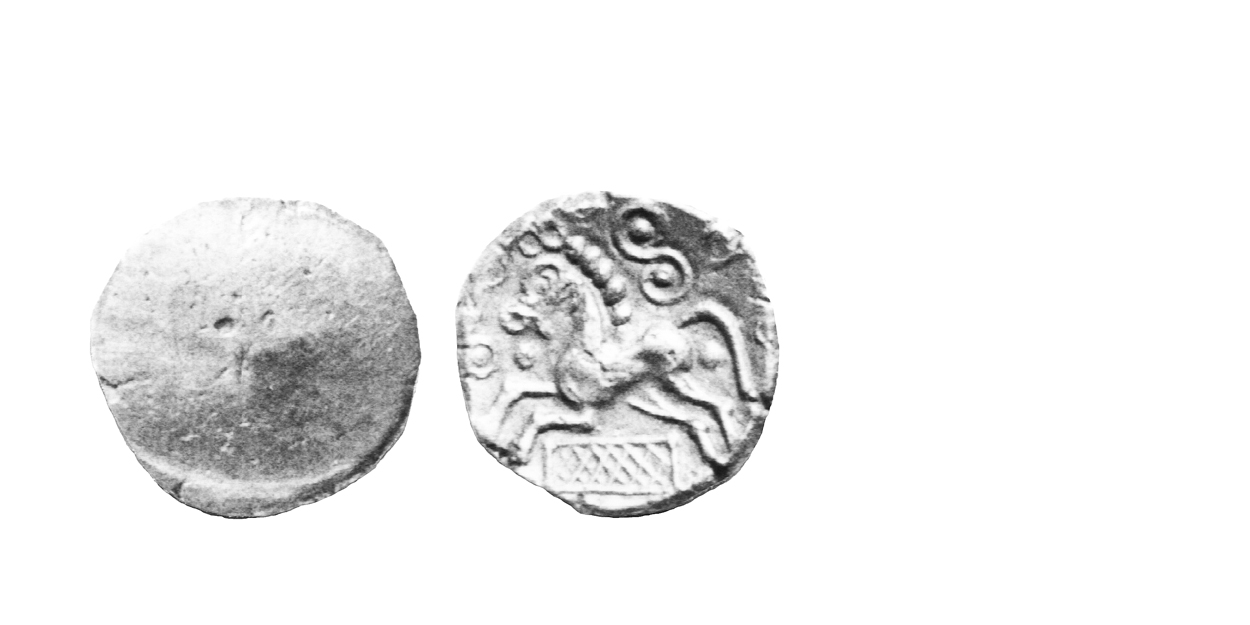
144 - 01 Early Weald Type
45-40 B.C. Extremely Rare
Gold Stater 16 mm 5.6 gms.
Earliest Record: Evans, 1864
OBV: plain
Identifying points:
1) no evidence of banding at this time
REV: Celticized horse left
Identifying points:
1) box with cross-hatching below horse done in neat workmanship
2) pellet below tail
3) pellet-in-ring motif in front of horse
4) S-shape with pellets in arms above horse
5) horse's right foreleg made up of a single line
CLASSIFICATION: Cantian G
NOTES:
- Some in museums
- Typical weight given
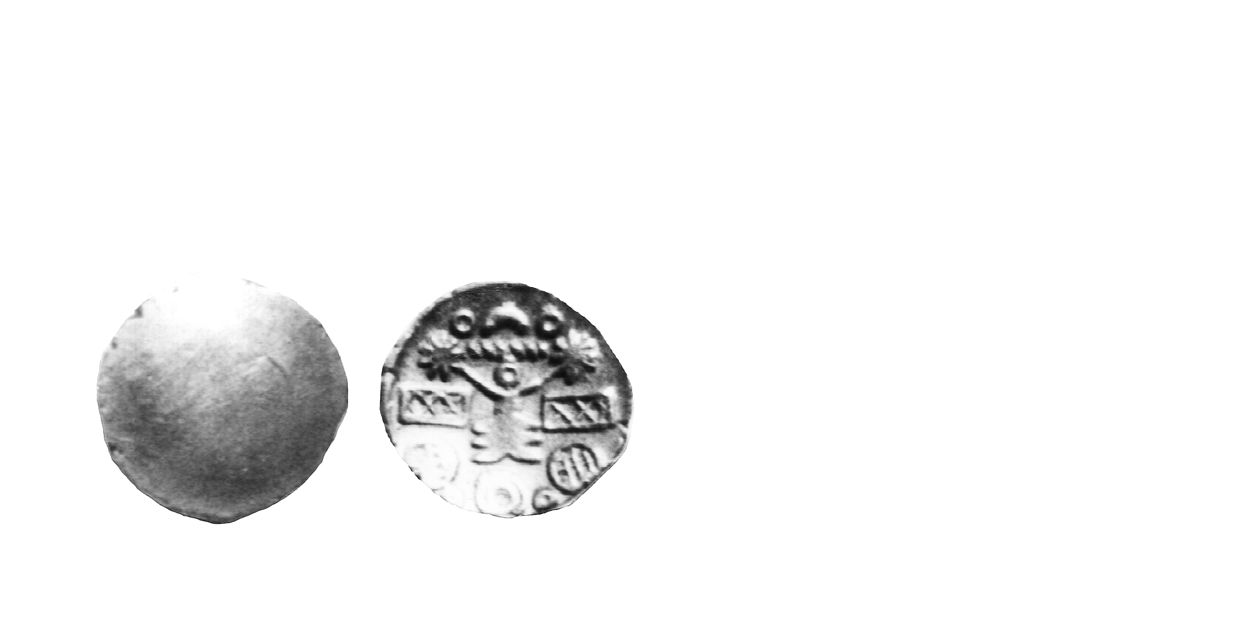
145 - 01 Early Trophy Type
45-40 B.C. Very Rare
Gold Quarter Stater 13 mm 1.3-1.6 gms.
Earliest Record: Evans, 1980
OBV: plain
Identifying points:
1) no evidence of banding at this time
REV: stylized Roman trophy
Identifying points:
1) trophy still recognizable
2) two rings with cross-hatching at 5 and 7 o'clock engraved with good workmanship
3) boxes with cross-hatching at 3 and 9 o'clock engraved with good workmanship
CLASSIFICATION: Cantian G
NOTES:
- Reverse design adapted from denarius of Caesar, BMC. 3961
- Traditionally described as a British type; possibly, but unlikely a Gaulish import
- Most in museums
- Typical weight given
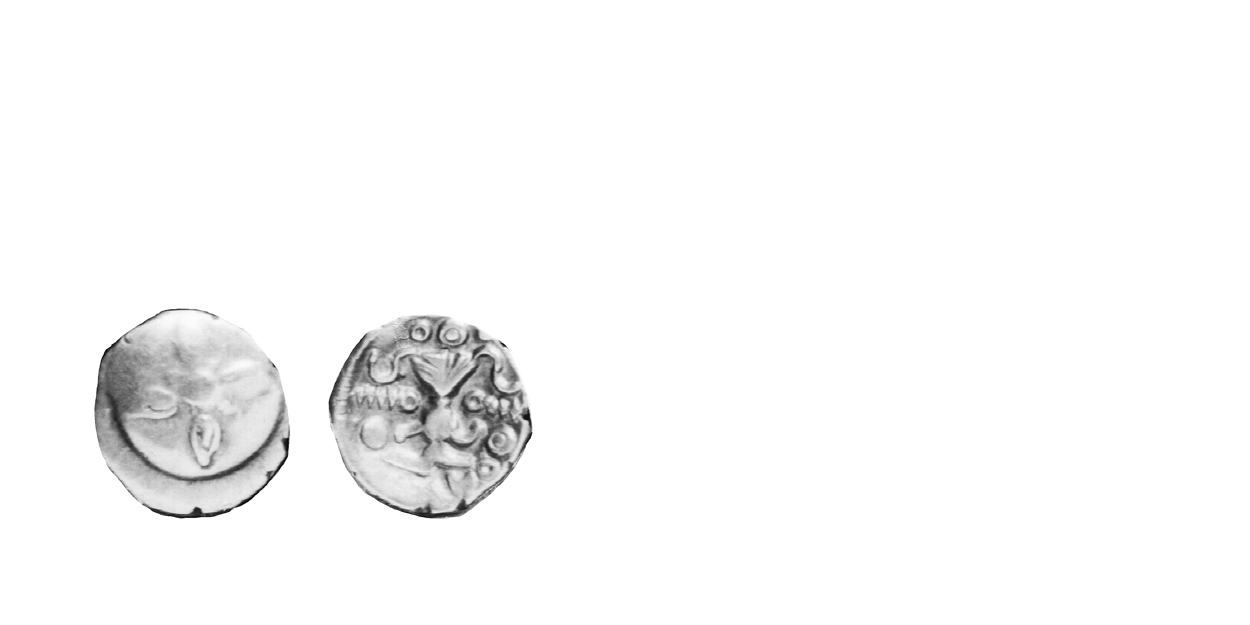
146 - 01 Middle Trophy Type
45-40 B.C. Extremely Rare
Gold Quarter Stater 10 mm 1.3-1.6 gms.
Earliest Record: Evans, 1864
OBV: Flower-like ornament in plain field
Identifying points:
1) field not ornamented
2) flower has four petals
REV: Stylized Roman trophy
Identifying points:
1) trophy highly stylized
2) rings at 5 and 7 o'clock replaced by simple pellets
3) boxes at 3 and 9 o'clock replaced by rows of pellets
CLASSIFICATION: Cantian G
NOTES:
- Traditionally described as Gaulish type, but more likely a part of the Kentish series on the basis of style
- Reverse design adapted from denarius of Caesar, BMC 3961
- Most in museums
- Typical weight given
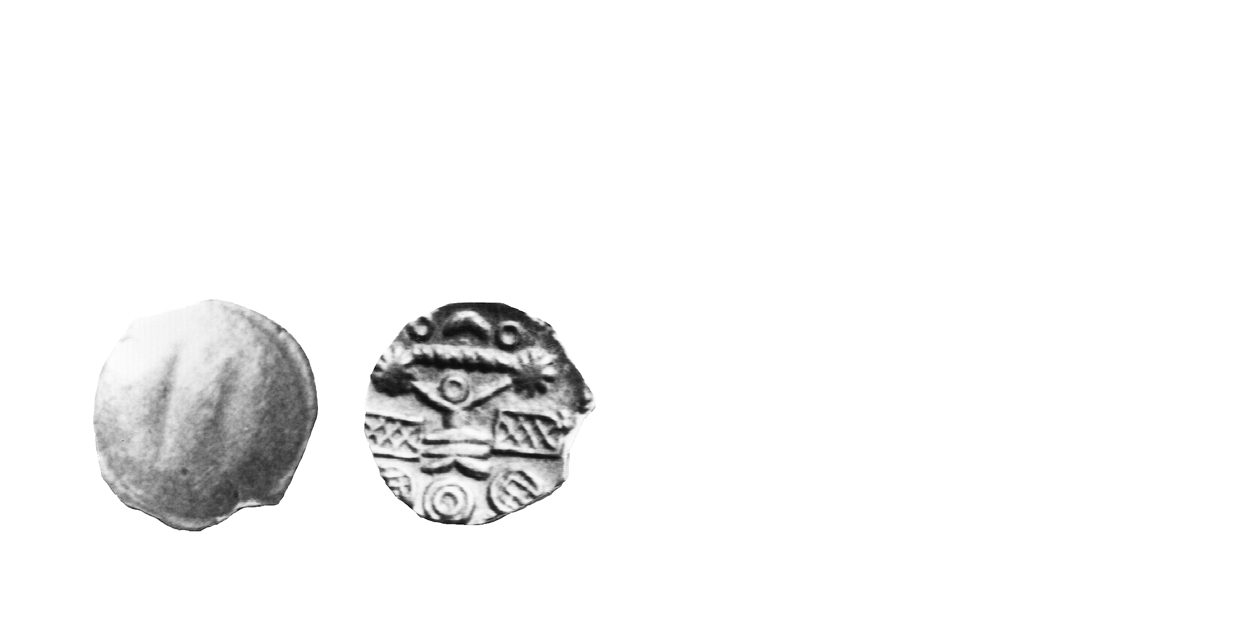
147 - 01 Late Trophy Type
45-40 B.C. Scarce
Gold Quarter Stater 11 mm 1.3-1.6 gms.
Earliest Record: Evans, 1864
OBV: Plain, perhaps banded
Identifying points:
1) Slight evidence for banding as seen on Third Struck Coinage types.
REV: Stylized Roman trophy
Identifying points:
1) Trophy highly stylized
2) Trophy made up of lines and pellets
3) Rings at 2 and 11 o'clock
4) Boxes at 3 and 9 o'clock as on 145-1
CLASSIFICATION: Cantian G
NOTES:
- Many in museums
- Celtic Coin Index records now indicate commoner than previously thought
- Reverse design adapted from denarius of Caesar, BMC (Spain) 86 or 89
- Traditionally described as a British type; possibly, but unlikely a Gaulish import
- Chronologically, this type may precede or be contemporary with the Middle Trophy Type
- Typical weight given
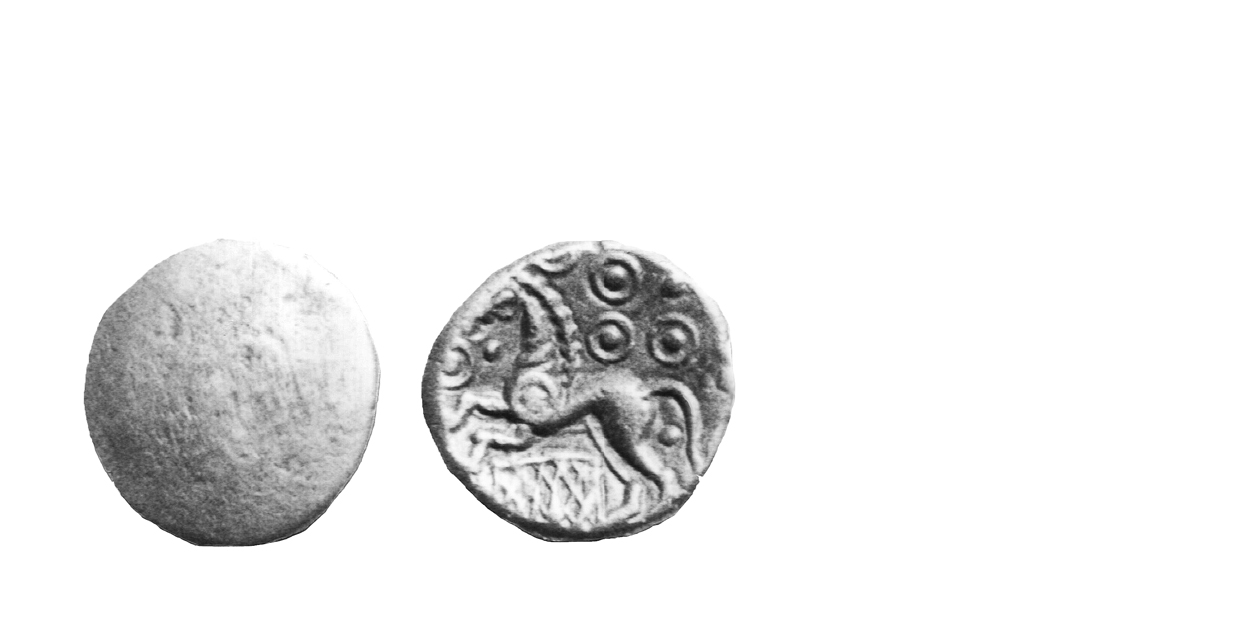
150 - 01 Late Weald Type
40-35 B.C. Extremely Rare
Gold Stater 15 mm
Earliest Record: Evans, 1864
OBV: Plain
Identifying points:
1) No evidence of banding at this time
REV: Celticized horse left
Identifying points:
1) box with cross-hatching below horse, engraved with less careful workmanship as 144- 1
2) pellet-in-ring motif on horse's shoulder
3) three pellet-in-ring motifs above horse
4) pellet-in-ring in front of horse
5) horse's right foreleg made up of a single line
CLASSIFICATION: Cantian H
NOTES:
- Some in museums
- Modern forgery exists - (see 150-01-F1)
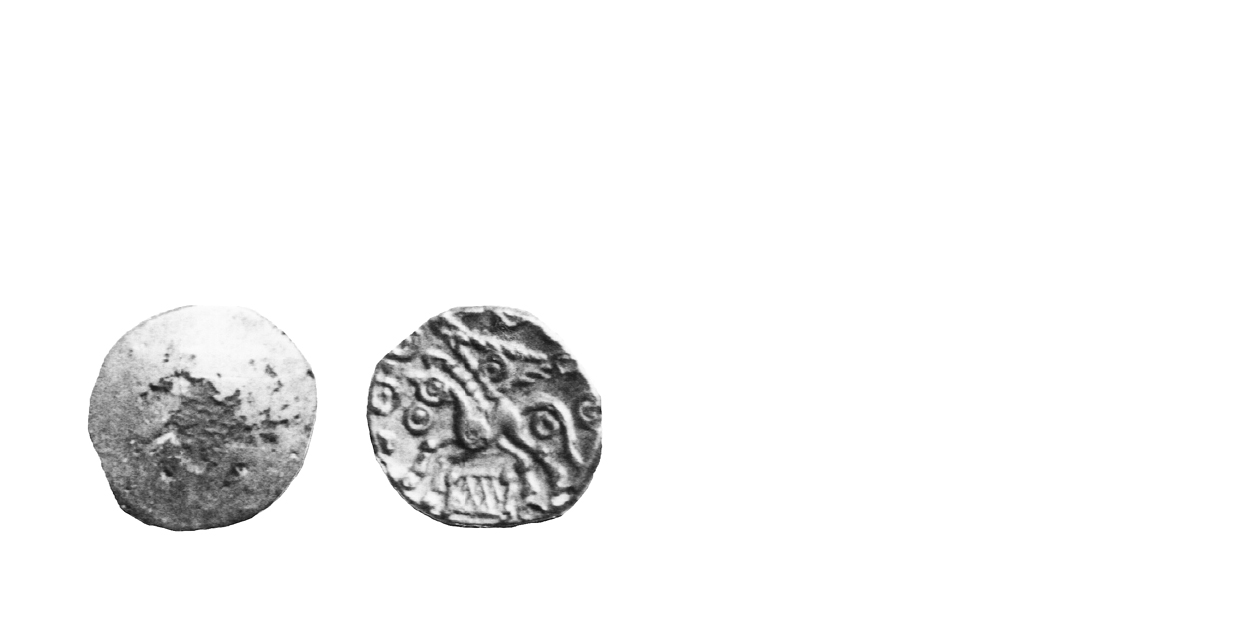
151 - 01 Late Weald Type
40-35 B.C. Common
Gold Quarter Stater 11 mm
Earliest Record: Evans, 1864
OBV: Plain
Identifying points:
1) No evidence of banding at this time
REV: Celticized horse left
Identifying points:
1) pellet-in-ring on horse's shoulder
2) pellet-in-ring motifs above horse
3) 'V' made up of one corded arm and one of short, parallel strokes
4) box with cross-hatching below horse, engraved with less careful workmanship as 144-1
5) horse's right foreleg made up of single line
CLASSIFICATION: Cantian H
NOTES:
- Some are in museums
153 - 01 Kentish Uncertain
ca. 50-30 B.C. Extremely Rare
Silver Minim 11 mm 0.4 gms.
Earliest Mention: Mack, 1964
OBV: Horseman right
Identifying points:
1) horseman holds spear or carnyx
REV: Seated man
Identifying points:
1) man wearing belt
2) man hold spear or staff to left
CLASSIFICATION: None
NOTES:
- Not illustrated
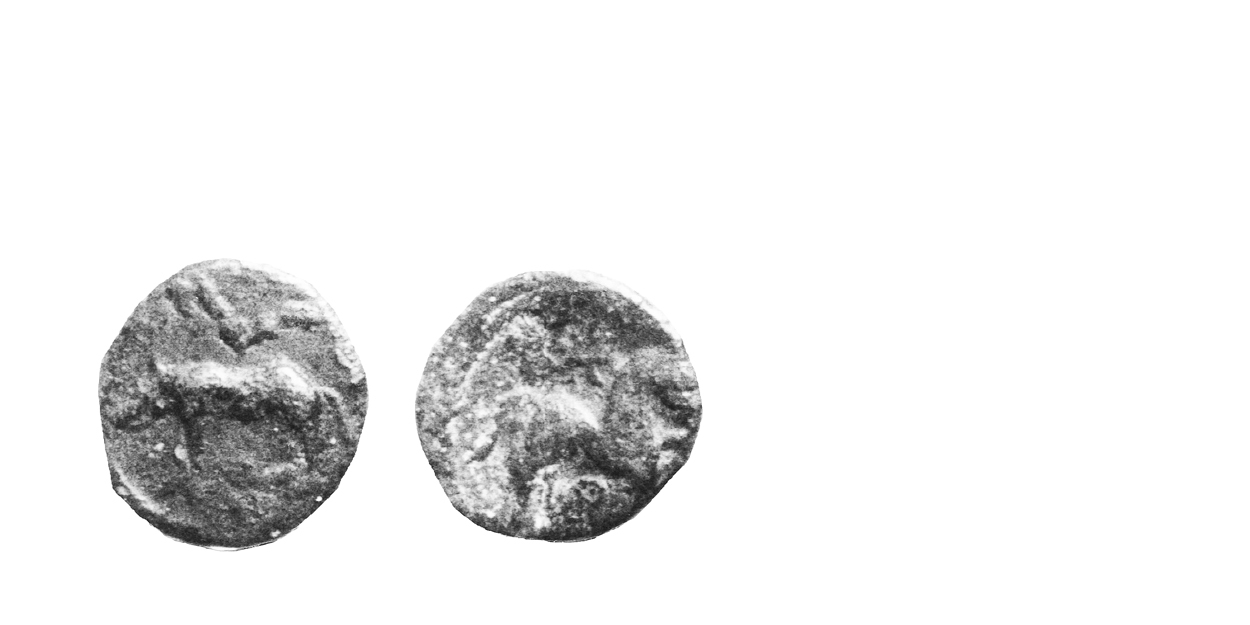
154 - 01 Kentish Uncertain
ca. 30-50 B.C. Scarce
Bronze Unit 18 mm 1.6 gms.
Earliest Record: Mack, 1953
OBV: Wolf left
Identifying points:
1) tree? behind wolf
2) rings in field
REV: Celticized horse right
Identifying points:
1) rings in field above horse
CLASSIFICATION: None
NOTES:
- Possibly earlier import from Gaul
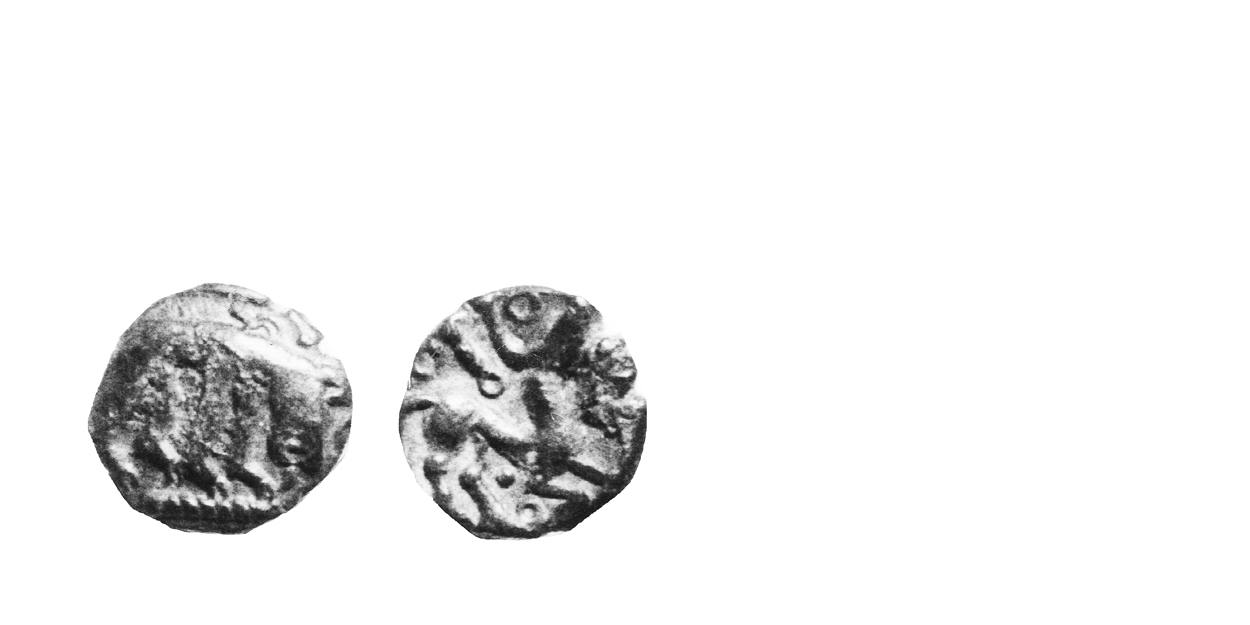
154 - 03 Kentish Uncertain
ca. 30-50 B.C. Rare
Bronze Unit 12 mm 2.1 gms.
Earliest Record: Evans, 1890
OBV: Uncertain animal right
Identifying points:
1) exergual line made up of pellets
REV: Uncertain animal right
Identifying points:
1) rings and pellets in field around animal
CLASSIFICATION: None
NOTES:
- Obverse possibly adapted from the Kentish Geometric Type, 143 - 1
154 - 05 Kentish Uncertain
ca. 30-50 B.C. Very Rare
Bronze Unit 13 mm
Earliest Record: Allen, 1960
OBV: Boar left
Identifying points:
1) pellet-in-ring motif below boar
REV: Lion right
Identifying points:
1) pellet-in-ring motifs above lion
CLASSIFICATION: None
NOTES:
- Not illustrated
154 - 07 Kentish Uncertain
ca. 30-50 B.C. Extremely Rare
Bronze Unit ca. 15 mm
Earliest Record: Evans, 1864
OBV: Uncertain animal right
Identifying points:
1) curved line above animal
REV: Celticized horse left
Identifying points:
1) pellet border
CLASSIFICATION: None
NOTES:
- Current whereabouts of coin uncertain, recorded in Evans, plate G14, in 1864
- Not illustrated
154 - 09 Kentish Uncertain
ca. 30-50 B.C. Rare
Bronze Unit 11 mm
Earliest Record: Allen, 1960
OBV: Head right
Identifying points:
1) too poorly preserved to identify
REV: Uncertain animal left
Identifying points:
1) pellets in field around animal
CLASSIFICATION: None
NOTES:
- Possibly an earlier import from Gaul
- Not illustrated
154 - 11 Kentish Uncertain
ca. 30-50 B.C. Extremely Rare
Bronze Unit 11 mm
Earliest Record: Mack, 1964
OBV: Pellet-and-Ring Motif
Identifying points:
1) Larger pellet-in-ring motif in center
2) seven rings surround central ring
REV: Uncertain
Identifying points:
1) too poorly preserved to identify
CLASSIFICATION: None
NOTES:
- Not illustrated
154 - 13 KENTISH UNCERTAIN
ca. 30-50 B.C. Extremely Rare
Bronze Minim 10 mm
Earliest Mention: Mack, 1964
OBV: Pellet-in-Ring Motifs
Identifying points:
1) four pellet-in-ring motifs surrounded by a ring of pellets
REV: Celticized horse right
Identifying points:
1) horse surrounded by ring of pellets
CLASSIFICATION: None
NOTES:
- Not illustrated
The First Struck Coinages in Kent
At the close of the Gallic War, about 50 B.C., imports of gold coins from Gaul would have nearly ceased. The need for coins prompted the Kentish tribes to strike their own. These first pieces had no inscriptions, but within thirty years, dynastic types appeared.
The uninscribed coins have been arranged in two successive issues. The type sequence starts with the ORNAMENTED TYPE staters, which carry on the reverse a horse in an elaborately-ornamented field. These, and the following types have plain obverses. The ORNAMENTED staters are quickly replaced hy the WEALD TYPE, a variety that suffers a decline in die-cutting workmanship over time.
The first inscribed variety, the SOUTH THAMES BANDED TYPE, has a wavy pattern in place of the plain obverse. The legends on the staters are almost off the flan on the existing coins, but enough is seen on one to suggest the letters 'IVII'. The succeeding inscribed coins continue the bands on the obverse.
Possibly, several tribes were simultaneously striking the different types. Although this would fit more closely with Caesar's comment that four 'kings' inhabited Kent, a simultaneous-production hypothesis is less likely. The coins appear to form a stylistic progression, hence a chronological order. Alternatively, the distribution of modern findspots does not offer enough support to suggest the different types were used in different parts of Kent.
Gold quarter staters are known for the two types of uninscribed staters. The first are a British version of the Gaulish GEOMETRIC TYPE, called the KENTISH GEOMETRIC TYPE. The design is soon changed to the TROPHY TYPE, which has a Celtic adaptation of the trophy motif seen on some of Caesar's denarii. Uninscribed quarters appear to have the same banded pattern as the 'IVII' SOUTH THAMES BANDED staters.

